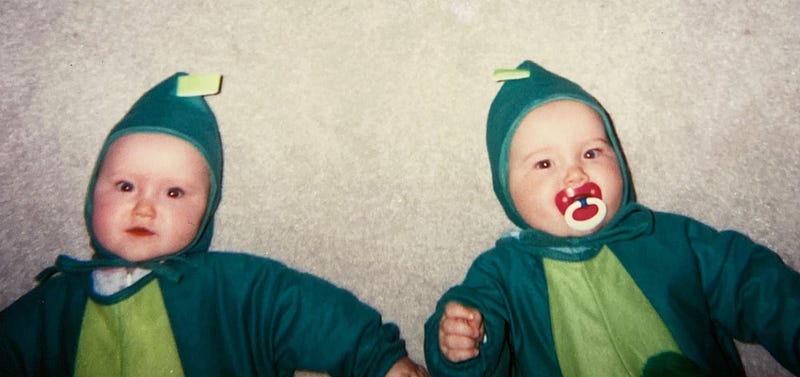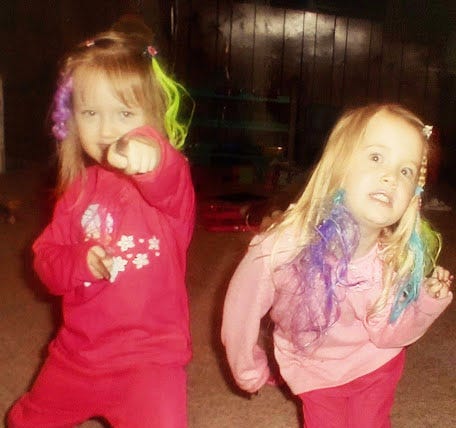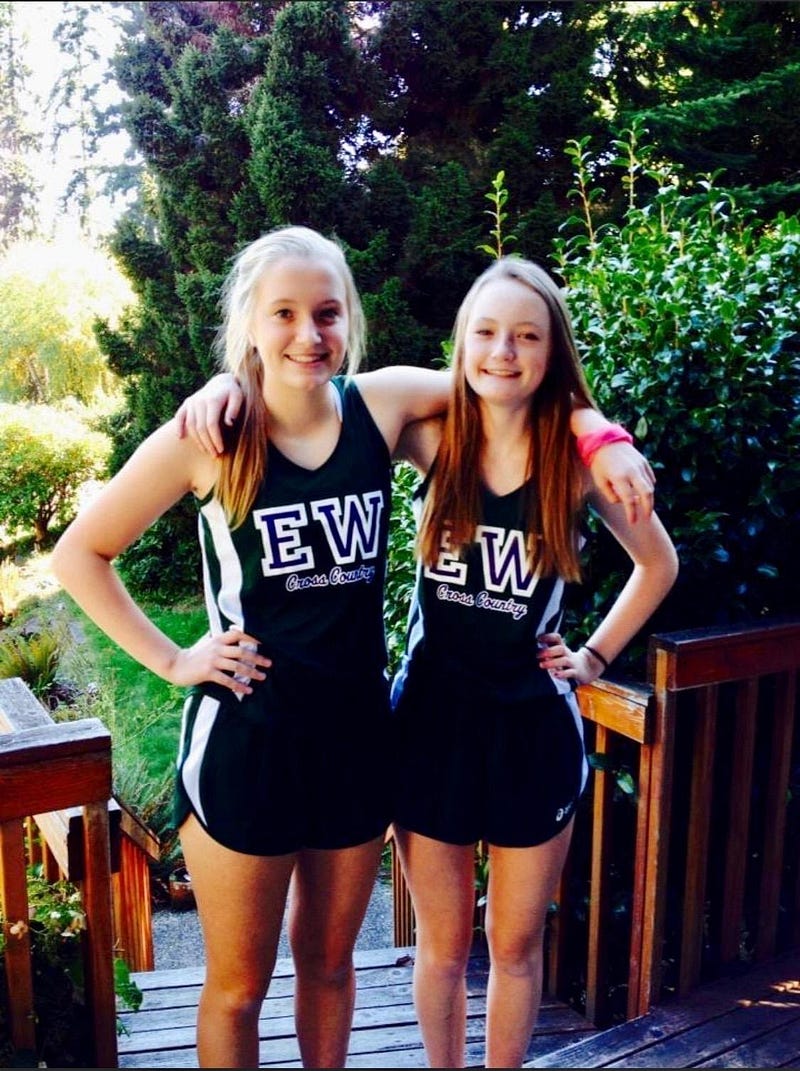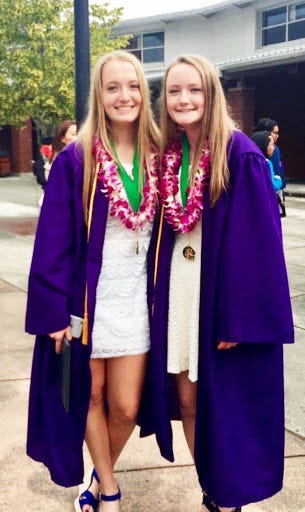Two Peas In A Pod
My journey on being a twin and finding individuality among our connectedness.
Story by Ally Burdett

“So like, can you two read each other’s minds?” someone for the third time that week asked us on the playground.
I recoiled shyly behind the awkward bangs I cut myself, a true symbol of middle school expression. Mady, on the other hand, her hair up tight in a ponytail and a bright open face, was ready to answer.
We knew each other’s roles: she talked, I listened.
“Well, actually, we sort of can,” Mady and I said at the same exact time, although her words were audible, and my words were just a thought in my head.
And it was true. Being a twin, you sort of can read each other’s minds.
That day on the playground, we were dressed exactly the same in our identical Catholic school-girl red plaid jumpers and navy blue church vests. We wore that uniform every single day for 10 years.
Besides that, you could barely tell we were sisters. She modeled sun-blonde hair, while I had “dishwater” blonde hair. There was a paint splatter of freckles all over my face, while Mady had just a few. I wore hot pink Pumas and Mady wore the latest basketball sneakers.
Growing up, we had our routine and our roles. These were our formative years ‒ the time when identity was like fresh, wet clay, and these experiences were the hands that were shaping us into adults. Molding us toward the place of individuality where Mady and I are now ‒ two separate countries doing two separate things.

When everyone saves a few words by lumping our names together as “the twins,” and when we share the same bedroom for 17 years, well, we’re going to be pretty close.
Yet, how did two sisters who shared the same clothes, slept between the same four walls for 6,205 days and had the same friends, end up 4,616 miles apart, with very different lives?
I asked my family members and close friends what ways Mady and I are different and how we are similar:
“You think things through, Mady reacts. You are a worrier, Mady is not.” ‒ Dad.
“You guys are different because you have way different lifestyles but you always connect really easily and know each other so well.” ‒ Jacob, our younger brother.
“If you weren’t sisters, I don’t think you’d even be friends,” Abby, our long-time friend from middle school said.
“Mady is very competitive and you’re more laid-back, Mady is more moody and you are more anxious, you’re creative and she’s athletic. But you are both super empathic.” ‒ Mom.

The subtle contrast in our childhood choices seemed to indicate the opposite directions Mady and I would go in ‒ quite opposite directions.
Throughout our lives, sports were a central component. For me, anxiety was just as much of a mental exercise as thinking out basketball plays was for Mady. Sometimes, I was too anxious to attend practice, so I’d make up an excuse to sit on the couch and watch reruns of “Project Runway.” Mady, on the other hand, had on her practice clothes the second school was out. She was always ready to lead the team.
She never struggled with social anxiety. For a long time in my life, it dictated what I did and didn’t participate in. I would miss out on overnight camps, sleepovers, and was forced to go to therapy. This always made me feel out of place, like I was missing a life secret Mady had discovered a long time ago.
Reflecting on this now, I think it helped shape our relationship and personalities. Mady was always more social, and I was more inclined to keep to myself. And I was fine with that; we had our roles and we were confident in our unique selves.
“Growing up, we were sort of conditioned to think we had to be the same,” Mady said. “We had the same haircuts, clothes, friends. But as high school does, it allowed us to start exploring our own authentic selves, in the best way possible.”
We both lived for sports, but our individual personalities shined differently on the court.
In high school, we were interviewed for, an article about twin athletes. The writer said, “Mady…assumed a major leadership role on the team. The Burdetts’ close relationship means that Mady can be a little more direct with Ally than she might be with other teammates.”
During our senior year, we both started on the varsity team and guided our team to state. Our “telepathy” may have given our team an advantage.
She leads, I listen.
The dynamic Mady and I shared while on the basketball court was clear, but it clarified to me that I was missing something Mady wasn’t.
Sports didn’t really fuel my creativity. I soon found myself dreading those early morning practices, while Mady always put in the extra time staying late after practice. I loved staying late to rebound for her because I could sense how much basketball meant to her. The electricity from the passion Mady had with basketball was something I wish I could someday find.
Little did Mady know that extra practice time would soon make her one of the top 3-point shooters in the NCAA Division III league, in the nation.
One day, while I was messing around on my electric keyboard,I could hear the “bounce, bounce, bounce” of the ball hitting the pavement outside, and it dawned on me. What sports did for Mady was what creative activities, such as music and art, did for me.
It became apparent senior year that Mady and I would be going our separate ways. I applied to schools that I thought would enable me to meet like-minded and creative people. Mady had numerous offers to play basketball for reduced tuition.
Then, on Sept. 1st, 2017, the thing that we never let ourselves think happened: Mady and I didn’t share the same bedroom for the first time in 17 years.
She slowly began tearing down her Stephen Curry posters, basketball championship trophies and team photos.
I looked around the room and thought about all the memories we’d shared in the small space.
Our matching clothes had long been swapped out with fighting over how our outfits looked too similar.
There was that huge dent in the wall from that time I accidentally distracted Mady and she slammed into it, breaking her nose.
Mady’s side of the wall always displayed the cross she received on her First Communion, while mine was covered by a Harry Styles poster and a hidden family secret of atheism.
Glancing at my One Direction shrine and late-night magazine collages that remained on the half-bare walls, I wondered, what will I do next?

4,616 miles apart. A nine hour time difference in our lives, yet only nine minutes apart in age.
Mady’s leadership skills and drive for sports appointed her team captain for the Whitman girls basketball team and landed her a free Master’s degree to play in Nottingham, England.
My listening skills and introverted qualities helped shape me to find that electricity found in a passion. I started to write, self-teach myself electric guitar and try many new art projects. It gave me an outlet to thrust all that anxious, mind-taxing energy toward being open to trying completely new things.
Which is what led me to both Bellingham, Washington and Seward, Alaska. Both of these places had two major things in common: I knew next to no one there. And that is what was exciting for me. It forced me out of my comfort zone and reminded me that although I had a person by my side for most of my life, I can do things on my own. And so can Mady.
“We share that deep history that will keep us close forever, yet we are able to depart and become our own selves, doing the things we love,” Mady told me through FaceTime, our only current means of communication.
4,616 miles apart, yet still close and doing the things we love, individually.
“Hey Siri, what time is it in Nottingham, England?”
-In England it is 3:00 a.m.-
I almost put my phone down disappointed, when Mady suddenly texts me, “Hi, I miss you so much!”
Twin telepathy!
